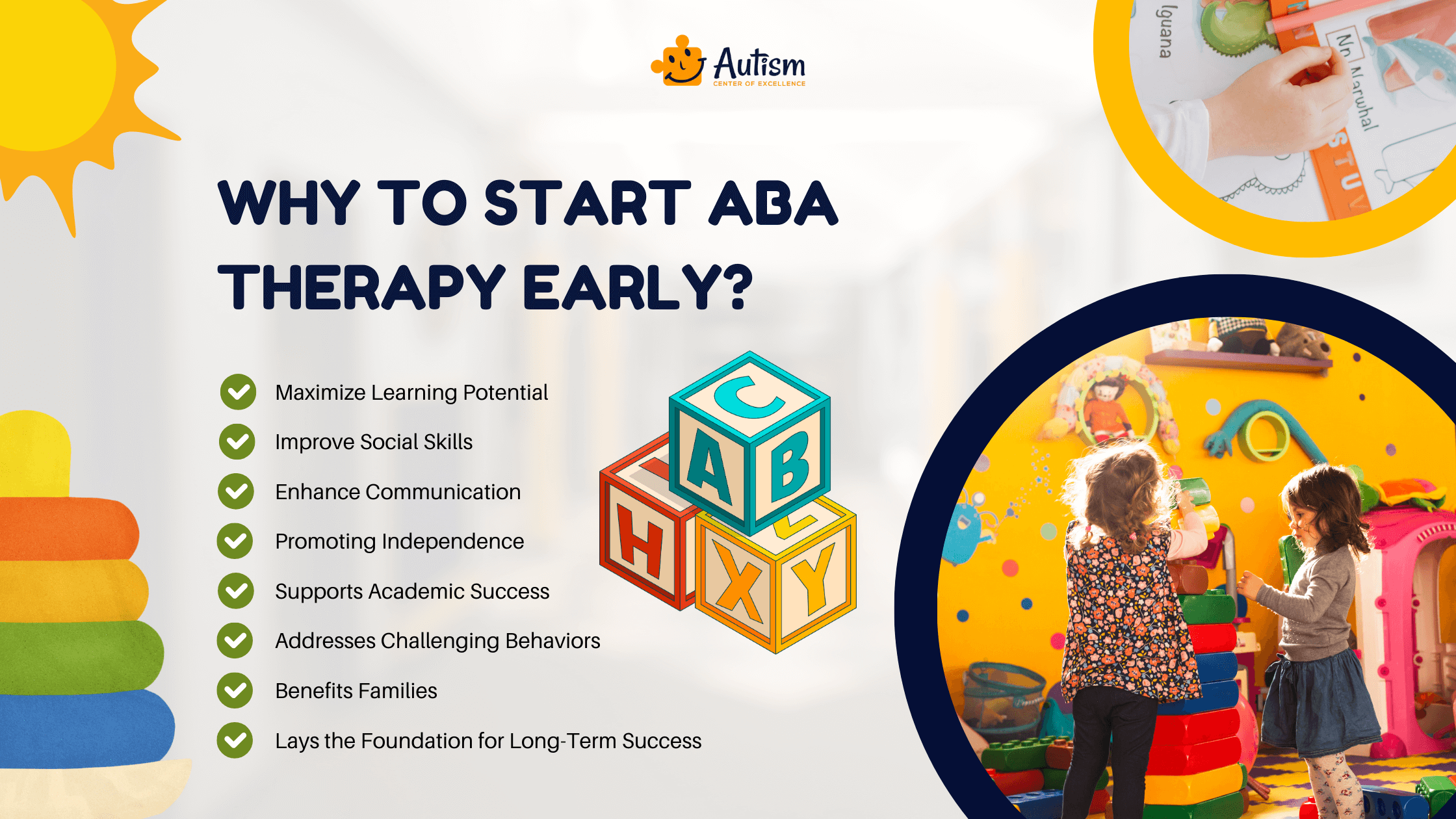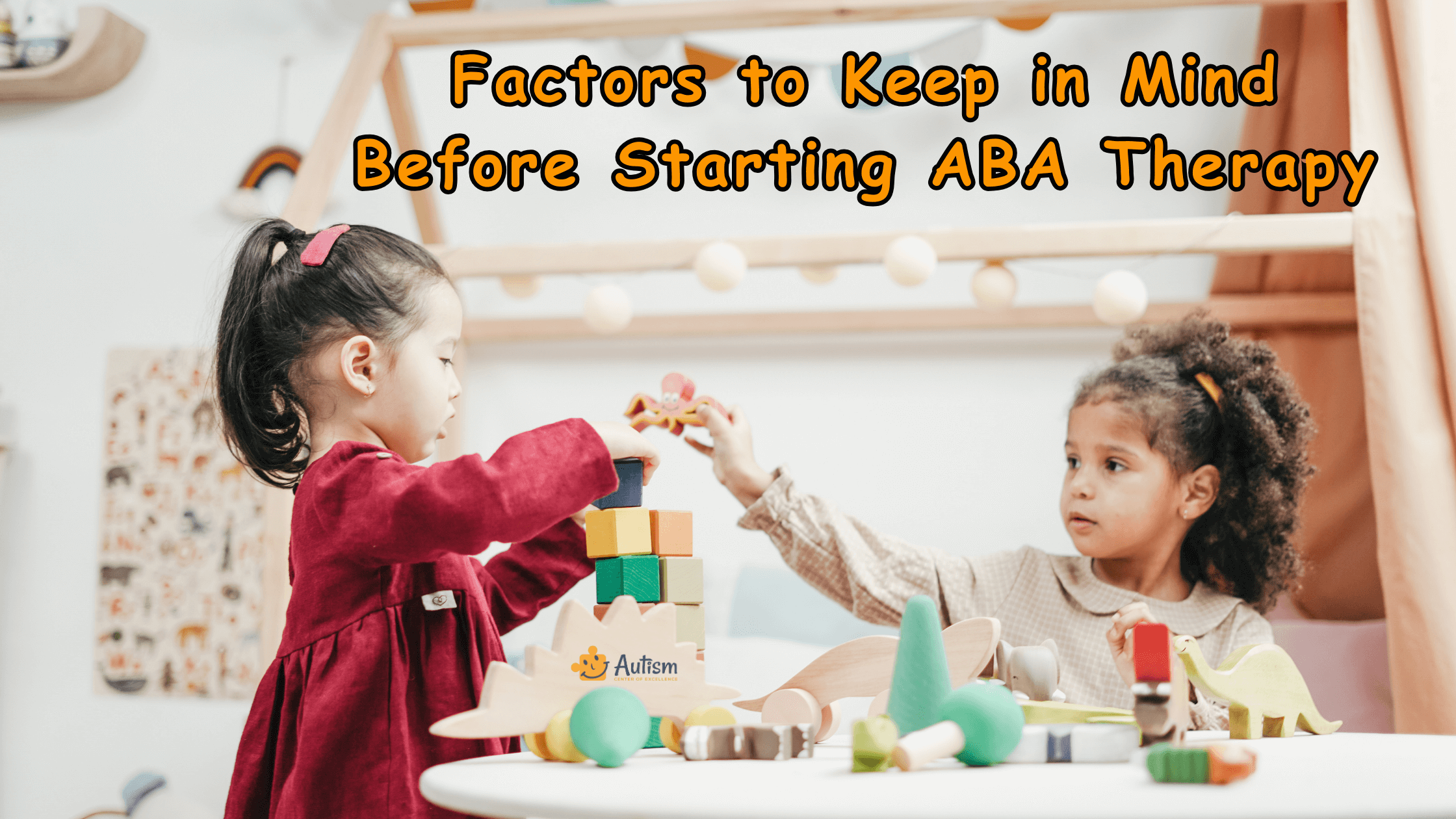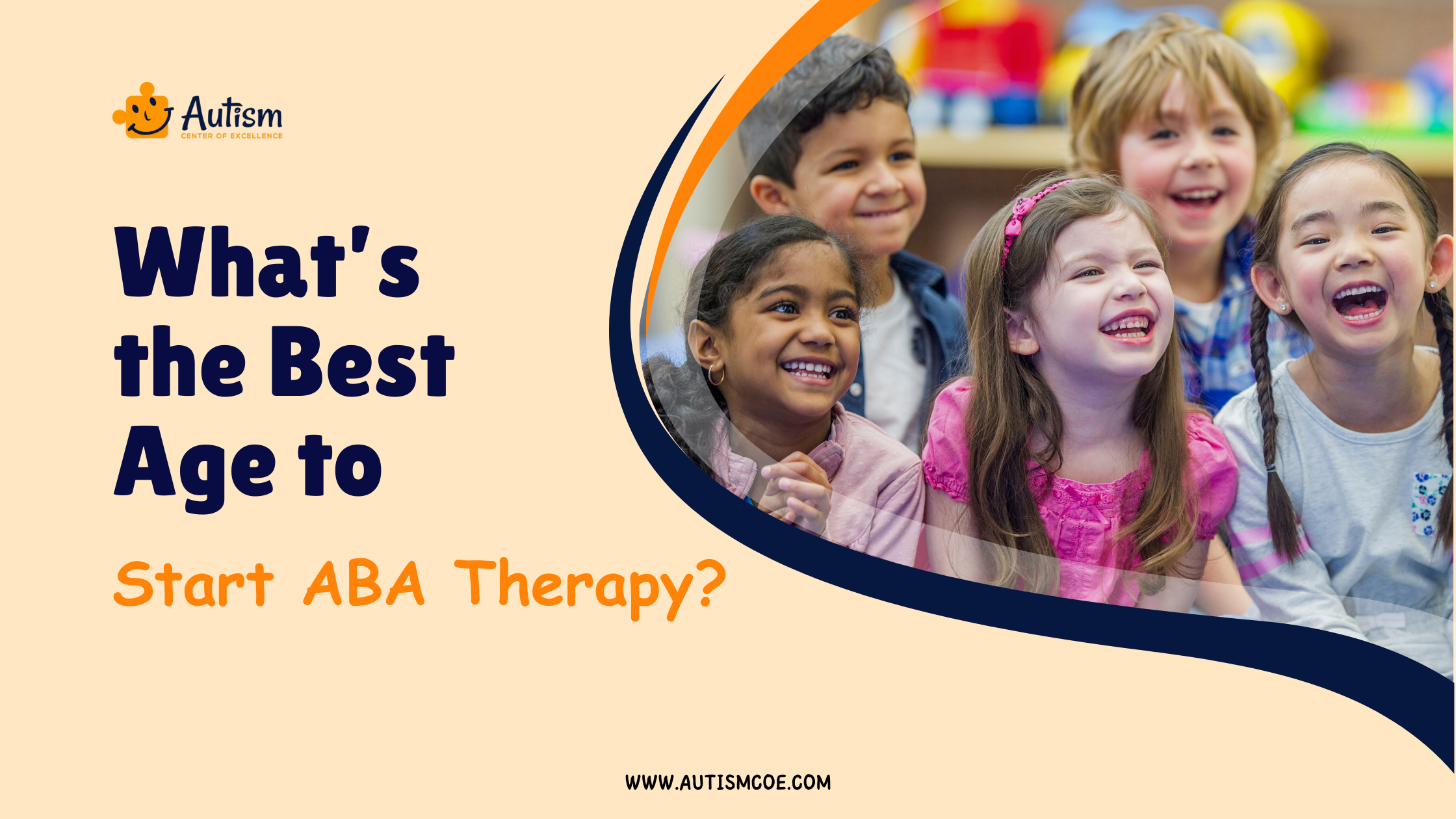Applied Behavior Analysis (ABA) therapy is recognized as one of the most effective interventions for children with Autism Spectrum Disorder (ASD). It is a comprehensive approach that focuses on understanding and improving behaviors by breaking them down into small, manageable steps. ABA therapy aims to teach children new skills, reduce problem behaviors, and enhance their overall quality of life. ABA therapy has shown remarkable effectiveness in helping children with autism learn and develop essential skills, such as communication, social interaction, and daily living activities. In this blog, we will explore the optimal aba therapy age to start ABA therapy and its importance in achieving positive outcomes for children with Autism.
Understanding ABA Therapy
Applied Behavior Analysis (ABA) therapy is a scientifically-based and evidence-based approach to understanding and modifying behavior. It is a comprehensive treatment that focuses on understanding and modifying behavior through systematic interventions. ABA therapy is a highly individualized approach, tailored to address specific behaviors and skills. The primary goal of ABA therapy is to enhance adaptive behaviors, reduce problematic behaviors, and promote overall independence and quality of life for individuals receiving the therapy.
ABA therapy focuses on breaking down complex behaviors into smaller, manageable steps. This method allows for targeted interventions that can be customized to meet the unique needs of each individual. By using positive reinforcement and other evidence-based techniques, ABA therapists work to increase desirable behaviors and decrease challenging behaviors. This approach is particularly effective for individuals with Autism Spectrum Disorder (ASD), as it helps them develop essential communication skills, social skills, and daily living skills.
When to Start ABA Therapy?
The optimal time to start ABA therapy can vary depending on individual circumstances, but generally, it’s recommended to begin as early as possible after a child is diagnosed with Autism Spectrum Disorder (ASD). Early Intervention is key because it allows for the greatest potential for improvement and development. Many experts suggest starting ABA therapy as soon as a child is diagnosed, often around the age of two or even younger.
┃Suggested – What Are the Early Signs of Autism?
Typically, children start ABA therapy between ages 2 and 6. Beginning at age 2, it aids in communication and prepares them for preschool. In older children, ABA is integrated into education, teaching social and daily living skills, and addressing behavioral challenges.
ABA therapy services are crucial across different age groups, from early childhood to adulthood, as they can be adapted to meet specific needs and life skills at each stage of life.
Starting ABA therapy early provides the opportunity to target critical skills during a child’s formative years when their brain is most receptive to learning and development. Early intervention can help address communication challenges, social skills deficits, and behavioral issues, laying the foundation for improved long-term outcomes.
However, it’s important to remember that ABA therapy can be beneficial at any age, and children of all ages can make progress with the right support and intervention.
What If ABA Therapy Starts Later?
While early intervention is ideal, starting applied behavior analysis therapy at an older age can still provide significant benefits. Older children, teenagers, and even adults with ASD can learn valuable skills and improve their quality of life through ABA therapy. The key is tailoring the therapy to suit the developmental stage and specific needs of the individual, no matter their age.

Why to Start ABA Therapy Early
Starting ABA therapy early offers a range of benefits for children with Autism Spectrum Disorder (ASD). Here are some key advantages:
Maximizing Learning Potential:
The first few years of a child’s life are a period of rapid brain development. During this time, children have the highest capacity for learning and adaptation. ABA therapy leverages this natural growth phase to maximize the child’s potential for developing new skills.
Improving Social Skills:
Early ABA therapy can significantly enhance a child’s social interactions. By focusing on social skills such as eye contact, turn-taking, and understanding social cues from a young age, children can better integrate and participate in social settings, such as school and community activities.
Enhancing Communication:
Many children with ASD struggle with verbal and non-verbal communication. Starting ABA therapy early helps address these challenges directly, teaching children effective ways to express their needs, desires, and emotions, which is vital for their overall development and well-being.
Promoting Independence:
Early ABA interventions focus on essential life skills and functional skills, including self-care, hygiene, and basic household chores. Learning these skills early on fosters independence and confidence, contributing to a higher quality of life as the child grows.
Supports Academic Success:
By developing cognitive and learning skills at a young age, children are better prepared for the academic demands of school. ABA therapy helps build foundational skills such as attention, following instructions, and task completion, which are critical for educational achievement.
Addressing Challenging Behaviors:
ABA therapy is effective in decreasing problematic behaviors often associated with ASD, such as self-harm, aggression, and tantrums. Initiating therapy early allows these behaviors to be addressed before they become more ingrained and more challenging to change.
Benefits Families:
The positive effects of early ABA therapy extend to family members as well. Parents and siblings often experience less stress and more joy in their relationships with the child. Furthermore, families gain valuable strategies and tools to support their child’s development effectively.
Lays the Foundation for Long-Term Success:
Research shows that early ABA therapy can lead to significant long-term improvements in IQ, language abilities, and daily living skills.
The early years are a critical period for intervening in the development of children with ASD. Starting ABA therapy during this window can significantly impact a child’s social, communicative, and cognitive development. While ABA therapy can be beneficial at any age, the unique advantages of early intervention highlight the importance of early diagnosis and treatment initiation for maximizing a child’s potential and improving their quality of life.
Join Our Weekly Newsletters!
Subscribe now to stay updated with our latest email updates.

Factors to Keep in Mind Before Starting ABA Therapy
Before starting Applied Behavior Analysis (ABA) therapy for a child with Autism Spectrum Disorder (ASD), several factors should be considered to determine the best age to begin the intervention:
1️⃣ Individual Needs:
Every child with Autism is unique, and their developmental trajectory may vary. Consider the child’s specific needs, strengths, challenges, and developmental level when determining the appropriate age to start ABA therapy.
2️⃣ Early Intervention:
Research shows Early Intervention leads to better outcomes, making it advisable to start ABA therapy before the age of five.
3️⃣ Assessment and Diagnosis:
Ensure your child has received a formal diagnosis of Autism and undergoes a comprehensive assessment before beginning ABA therapy.
4️⃣ Family Readiness:
Assess your family’s readiness and commitment to actively participate in the therapy process. ABA therapy often involves intensive and consistent involvement from parents, so it’s crucial that they are prepared to dedicate time and effort to support their child’s progress.
5️⃣ Availability of Providers:
Check for qualified ABA therapists in your area before starting therapy. Like AutismCOE, which provides the best-in-class ABA services, ABA for Early Intervention, ABA for School Readiness, Speech Therapy, and Occupational Therapy
6️⃣ Integration with Other Interventions:
Consider how ABA therapy can complement other interventions your child may be receiving, such as speech or Occupational Therapy.
7️⃣ Progress Monitoring:
Regularly assess your child’s progress and adjust the therapy plan as needed to ensure effectiveness.
Above factors should be considered before beginning ABA therapy for a child with Autism. By carefully considering these factors, parents can make informed decisions about the best age to start ABA therapy for their child.
Frequently Asked Questions & Answer
What is the Best Age for Autism Therapy?
The best age for autism therapy varies depending on the individual child’s needs and circumstances. However, early intervention is generally recommended, with many experts suggesting starting therapy as soon as autism is suspected or diagnosed, often before the age of five.
Is 6 Years Old Too Late for ABA Therapy?
While starting ABA therapy earlier is generally recommended, it is not necessarily too late to begin at six years old. ABA therapy can still be beneficial for children at this age, especially when tailored to their individual needs and goals. However, early intervention often leads to better outcomes.
What Age is High Risk for Autism?
Autism spectrum disorder (ASD) can typically be diagnosed as early as two years old, but signs may appear even earlier. Children between the ages of 18 months and two years are considered high risk for autism, as this is when symptoms often become more noticeable.
Do Parents Stay at ABA Therapy?
In many cases, parents are encouraged to participate in ABA therapy sessions, at least initially. This involvement allows parents to learn strategies for supporting their child’s progress at home and in other settings. However, the level of parental involvement may vary depending on the child’s needs and the specific goals of the therapy program.
Choosing ABA Providers
Choosing the right ABA provider is crucial for individuals with Autism Spectrum Disorder (ASD) and other developmental disorders. When selecting an ABA provider, it is essential to consider their qualifications, accreditation, and experience. Look for providers who have the necessary certifications and credentials in the field of ABA therapy, such as Board Certified Behavior Analysts (BCBAs) and Board Certified Assistant Behavior Analysts (BCaBAs). Additionally, consider the provider’s accreditation status, such as accreditation from the Behavioral Health Center of Excellence (BHCOE) or the Commission on Accreditation of Rehabilitation Facilities (CARF). A qualified ABA provider will work closely with individuals and their families to develop a personalized treatment plan that addresses specific goals and objectives.
It’s also important to evaluate the provider’s experience in working with children of different ages and developmental stages. An experienced provider will be adept at tailoring their approach to suit the specific needs of each child, ensuring that the therapy is both effective and engaging. Furthermore, consider the provider’s approach to family involvement. Effective ABA therapy often requires active participation from family members, so a provider who offers training and support for parents can be particularly beneficial.
By carefully selecting a qualified and experienced ABA provider, families can ensure that their child receives the highest quality of care and support, leading to positive outcomes and improved quality of life.
Conclusion
In Conclusion, determining the optimal age to begin ABA therapy for a child with Autism is crucial for their development. While starting early, ideally before the age of five, often yields the most significant benefits, each child’s situation is unique. Consulting with AutismCOE can help parents make informed decisions tailored to their child’s specific needs. AutismCOE provides ABA Therapy, Autism Early Intervention Program, Autism School Readiness Program, Speech Therapy, and Occupational Therapy services for children aged 2 – 14 years in-home as well as in center-based environments. By prioritizing early intervention and seeking professional guidance, parents can provide their child with the support they need to thrive.
Please Note: The content of this blog is for informational purposes only and should not be considered a substitute for professional medical advice, diagnosis, or treatment. Consult a qualified health care professional for personalized guidance tailored to your specific situation.

Bhavika Bhasin
Bhavika Bhasin is the Research and Marketing officer at AutismCOE. She works with children and adults with ASD. Her clinical research includes evaluating various available autism screening and diagnosis methods and their efficacy. She is currently developing a novel screening exam that is indicated to be more accurate than the existing available exams. She is also writes articles papers for various publications.


